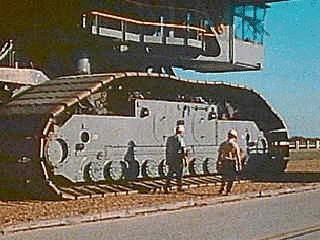Crawler Transporter
Today, we ride on the world's largest land transport vehicle. The University of Houston's College of Engineering presents this series about the machines that make our civilization run, and the people whose ingenuity created them.
What do you suppose the largest land transport vehicle is? A bus, a train, an earth-mover? Actually, its the crawler transporter developed for NASA to carry an assembled Saturn rocket on its five-mile journey from the assembly building to the launching pad.
This strange vehicle makes more sense as an engineering accomplishment when we realize the magnitude of its task. It had to carry a 12-million-pound rocket and launching derrick, and it had to keep them within ten minutes of an arc of a pure vertical position while it negotiated grades of as much as five degrees.
The crawler transporter was selected in preference to both a special barge-and-canal system and a rail system. What finally emerged was something out of science fiction. It's 131 feet long and 114 feet wide. It weighs 6 million pounds. The structure rides on four double tracks -- each pair the size of a Greyhound bus. Inside its huge deck are diesel engines with a total output of almost 8000 hp. They drive generators that supply electric motors for the tracks, for the immensely-delicate leveling mechanism, for the cooling systems, and for other internal functions.
The five-mile journey requires a highly trained crew of eleven people: a driver, four observers at different locations to advise the driver on steering, and six technicians. The crawler moves at 2 mph unloaded and 1 mph with the rocket in place. Its fuel economy is about 1/150th of a mile per gallon.
And who built this high-tech behemoth? Actually, two were built, and they weren't products of the aerospace industry. They were made by the Marion Power Shovel Company of Ohio -- a company with experience in heavy moving technology. The crawlers each cost $14 million in 1967, when they were put into service.
This is the sort of design challenge that gives engineers enormous pleasure -- a new machine that must conform to a set of extraordinary requirements -- an array of decisions and component inventions that molds dramatic function out of thin air.
I'm John Lienhard, at the University of Houston, where we're interested in the way inventive minds work.
(Theme music)
The NASA Crawler Transporters were named a National Historic Mechanical Engineering Landmark by the American Society of Mechanical Engineers on Feb. 3, 1977 at the John F. Kennedy Space Center. Information for this episode was obtaind from the dedicatory brochure for that ceremony.
This episode has been substantially revised as Episode 1361.

Clipart

Clipart